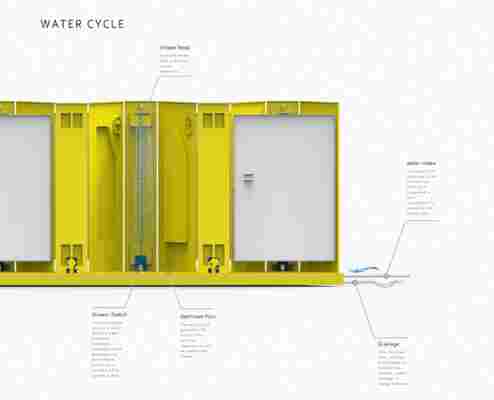{"type":"video","version":"1.0","provider_name":"Vimeo","provider_url":"https://vimeoom/","title":"YEZO (Hokkaido, Japan, 2020)","author_name":"LEAD","author_url":"https://vimeoom/leaddotpro","is_plus":"0","account_type":"basic","html":"<iframe src="https://player.vimeoom/video/431349540?h=a512489a67&dnt=1&app_id=122963" width="1050" height="591" frameborder="0" allow="autoplay; fullscreen; picture-in-picture" allowfullscreen title="YEZO (Hokkaido, Japan, 2020)"></iframe>","width":"1050","height":"591","duration":"102","description":"YEZO is a small retreat, nestled in the northern mountain range of Hokkaido, Japan, that takes advantage of the dramatic landscape and an experimental design approach to create a private sanctuary surrounded by nature. Its lean tectonic system combined with only a most essential spatial programme redefines the modern meaning of true luxury: a place and time for quiet reflection and private enjoyment in a setting defined by wood, stone, water, and light, surrounded by ever-changing natural beaunThe project’s elegant and fluid space follows a highly minimalist, yet expressive, performance-driven material and construction approach. The wooden roof shell structure is built up from glue-laminated (GluLam) timber beams suspended from a central concrete chimney and clad with regionally sourced black slate. GluLam timber is a structural engineered wood product that reduces reliability on less-sustainable old growthdependent solid-sawn timber. YEZO’s curved GluLam beams are carefully shaped to operate in pure tension throughout, resulting in a weight- and material reduction of 90% when compared to straight beams. Their shape is optimised to allow fabrication from one single mould. This approach minimises the project’s ecological impact and reduces manufacturing cost and delivery time while maintaining a highly qualitative spatial designnLOCATION | Hokkaido, JapannLEAD DESIGN TEAM | Kristof Crolla, Julien KlisznCLIENT | Private","thumbnail_url":"https://i.vimeocdnom/video/912624369-b6afc82899264c2afe1a08fde5e609f726abad753b7cff05f26913e9d1fd843e-d_960","thumbnail_width":"960","thumbnail_height":"540","thumbnail_url_with_play_button":"https://i.vimeocdnom/filter/overlay?src0=https%3A%2F%2Fi.vimeocdnom%2Fvideo%2F912624369-b6afc82899264c2afe1a08fde5e609f726abad753b7cff05f26913e9d1fd843e-d_960&src1=http%3A%2F%2Ff.vimeocdnom%2Fp%2Fimages%2Fcrawler_play.png","upload_date":"2020-06-22 01:33:02","video_id":"431349540","uri":"/videos/431349540","arve_cachetime":"2021-09-27 05:29:35","arve_url":"https://vimeoom/431349540"}
Designed for idyllic Hokkaido in Japan, the YEZO is a retreat that uses its dramatic landscape and an experimental design approach to create a sanctuary in nature. The YEZO’s overall design is a fusion of both aesthetics and algorithms, optimised for fabrication from one single mould to minimise ecological impact and reduce manufacturing cost and delivery time. It features a unique curved roof that not only creates a spacious interior, but even provides a channel for the central chimney while creating a small terrace/skylight in the process. The wooden roof shell structure, clad with regional black slate, consists of sustainable GluLam (glue-laminated) timber beams suspended from a central concrete chimney. “YEZO’s curved GluLam beams are carefully shaped to operate in pure tension throughout, resulting in weight and material reductions of 90% compared to straight beams”, say Kristof and Julien, the designers behind the award-winning retreat.
The YEZO Retreat is a winner of the Golden Pin Design Award for the year 2020.
Designers: Kristof Crolla & Julien Klisz
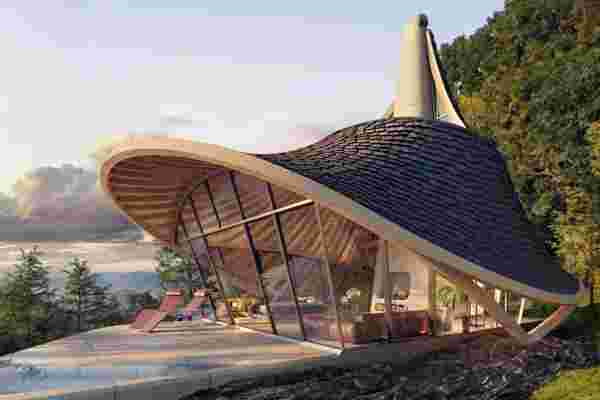
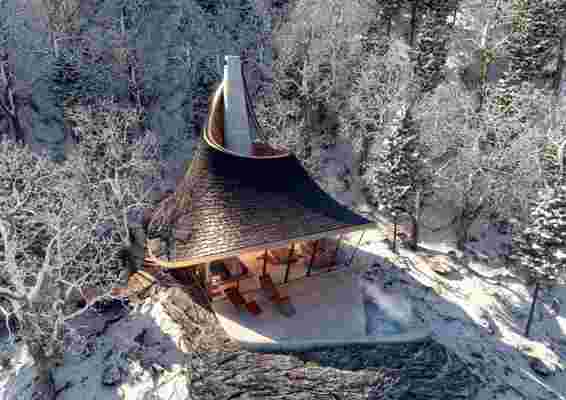
This concrete cubic home’s CNC cut plywood spiral staircase visible from the outside!
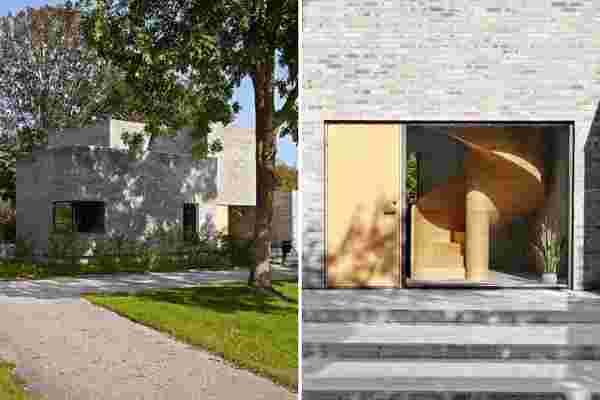
The first thing a person notices when entering your home sets the tone. Of course, how this ‘rule’ comes to life varies from home to home. The first thing someone might notice could be your favorite piece of artwork hanging in the corner, the amount of natural lighting, a view of the ocean in the distance, or it could be a messy shoe rack and markings on the wall. Whatever the case may be, for Danish architect Tommy Rand’s family home, he was sure to make the home’s main event, a handmade, spiral staircase , visible even before walking through the front door.
Somewhere in Aarhus, Denmark, Tommy Rand both designed and constructed his family’s home out of concrete and Norwegian Skifer stone, along with the home’s interiors and most of its wooden furniture. The concrete dwelling consists of five blocks, each one peaking from different angles, creating the subtle illusion of looking toward a tiny city’s skyline. The cluster of blocky stone perches dons a multi-tone brick exterior, with a smooth concrete finish, and offers elevated, semi-enclosed deck areas with views of the surrounding neighborhood. Looking through the home’s wide, ground-level window, its stone-cold attitude is soon visually warmed up even before walking through the front door. From the home’s front-facing window, Tommy Rand’s hand-constructed spiral staircase provides a warm welcome.
Made from 630 pieces of CNC-cut plywood, the spiral staircase was assembled and glued inside Rand’s concrete home for true measurements and onsite adjustments. The staircase itself exudes playfulness and indicates a family residing inside the home’s sturdy and thick concrete facades. The combination of Norwegian Skifer stone and concrete otherwise works to balance out the staircase’s gentler wooden accents with an overarching cool and hearty tone. The concrete’s immensity feels stable, mighty, and calming while the rich, subtly stained wooden accents bring the home’s interiors to life with rustic warmth, artfulness, and changing textures. Moving through the home, glazed windows let in natural light to ricochet from the glossy, wooden cabinets, tables, and doors that sprout between cool gray, concrete panels.
Concrete homes are generally known to be more energy-efficient with proper insulation acquired either through insulating foam or other thermal insulating methods. The thick concrete equips the home with innate strength and durability, providing a solid base for proper, sustainable insulation to keep the home warm during colder months and cool during the summer season. Even when it comes to literal warmth and coolness, from every corner of this home, it seems that a looming, cooler backdrop built from concrete naturally invites the heat that comes with a wooden finish.
Designer: Tommy Rand
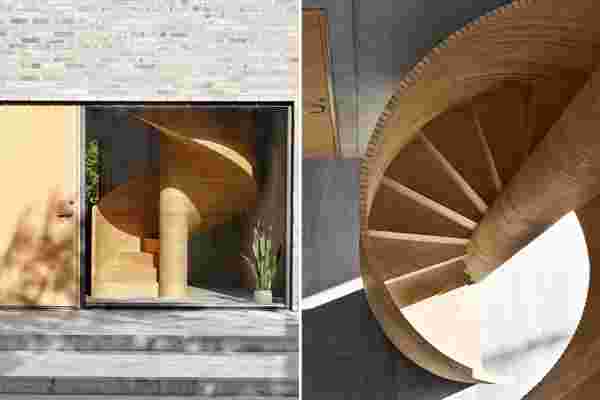
These foldable bathrooms can be instantly assembled at refugee camps
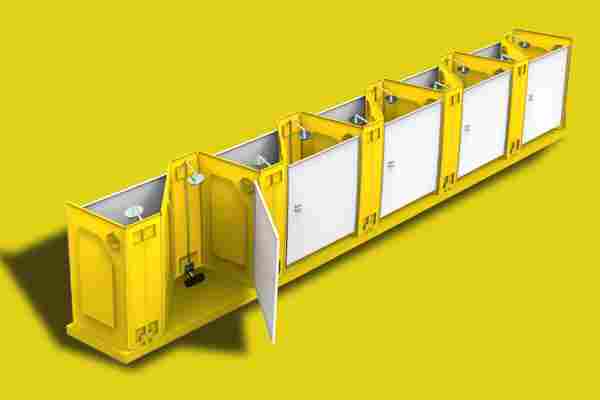
Designed to be set up at refugee camps in a matter of mere minutes, these bathrooms can be unfolded in a matter of minutes, giving large groups of people a private place to have a shower every day.
The Speedy Collapsible Bathrooms aren’t really replacements for ‘Portaloos’, but are an addition to them, as they provide private showering quarters for refugees. These showering stations come as a single foldable clapboard that can easily be unfolded on-site, with details like floor panels, doors, plumbing, and other attachments being plugged in within mere minutes. Once the clapboard is assembled, the shower-head (which flat-packs too) can easily be assembled along with a foot-powered pump at its base. The final step involves mounting the door units and the elevated floorboards which allow the water to drain from underneath. Water for showering can be pumped through an inlet on the side, although if the water pressure ever drops, a foot-pump in each showering booth lets people easily pump their own water as they bathe.
The Speedy Collapsible Bathrooms are designed to be easy to assemble and effective, but also easy to pack up once done. When the refugee camp is no longer needed, the bathroom can be unplugged and repackaged once again, allowing as many as 10 showering booths to fold up and occupy a fraction of the space on the back of a cargo truck.
The Speedy Collapsible Bathrooms are a winner of the Golden Pin Design Award for the year 2020.
Designer: Ze-Hong Mo
